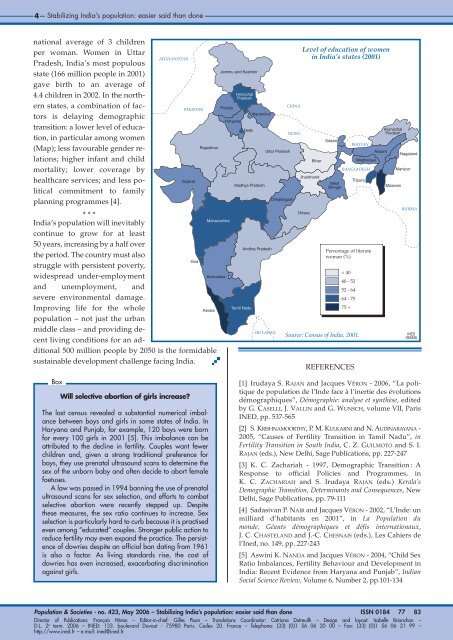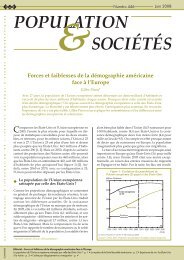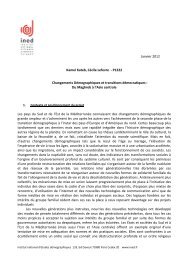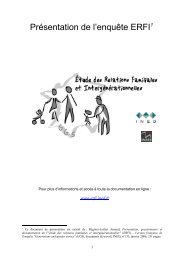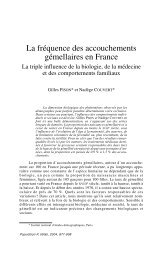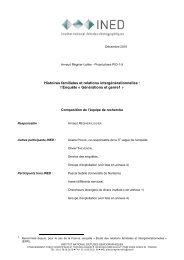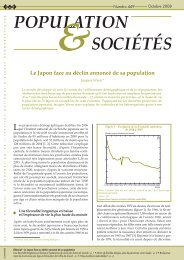Stabilizing India's population: easier said than done - Ined
Stabilizing India's population: easier said than done - Ined
Stabilizing India's population: easier said than done - Ined
- No tags were found...
You also want an ePaper? Increase the reach of your titles
YUMPU automatically turns print PDFs into web optimized ePapers that Google loves.
4 <strong>Stabilizing</strong> India’s <strong>population</strong>: <strong>easier</strong> <strong>said</strong> <strong>than</strong> <strong>done</strong>national average of 3 childrenper woman. Women in UttarAFGHANISTANPradesh, India’s most populousstate (166 million people in 2001)gave birth to an average of4.4 children in 2002. In the northernstates, a combination of factorsis delaying demographicPAKISTANtransition: a lower level of education,in particular among women(Map); less favourable gender relations;higher infant and childRajas<strong>than</strong>mortality; lower coverage byhealthcare services; and less politicalcommitment to familyGujaratplanning programmes [4].* * *India’s <strong>population</strong> will inevitablycontinue to grow for at least50 years, increasing by a half overthe period. The country must alsoGoastruggle with persistent poverty,widespread under-employmentand unemployment, andsevere environmental damage.Improving life for the wholeKerala<strong>population</strong> – not just the urbanmiddle class – and providing decentliving conditions for an additional500 million people by 2050 is the formidablesustainable development challenge facing India.Jammu and KashmirPunjabMaharashtraKarnatakaHaryanaHimachalPradeshDelhiUttaranchalMadhya PradeshTamil NaduAndhra PradeshSRI LANKAUttar PradeshChhattisgarhCHINANEPALLevel of education of womenin India’s states (2001)BiharJharkhandOrissaSikkimWestBengalPercentage of literatewoman (%)< 4040 - 5252 - 6464 - 7575 +REFERENCESBHUTANAssamMeghalayaBANGLADESHTripuraSource: Census of India, 2001.ArunachalPradeshMizoramNagalandManipurBURMAINED093A06BoxWill selective abortion of girls increase?The last census revealed a substantial numerical imbalancebetween boys and girls in some states of India. InHaryana and Punjab, for example, 120 boys were bornfor every 100 girls in 2001 [5]. This imbalance can beattributed to the decline in fertility. Couples want fewerchildren and, given a strong traditional preference forboys, they use prenatal ultrasound scans to determine thesex of the unborn baby and often decide to abort femalefoetuses.A law was passed in 1994 banning the use of prenatalultrasound scans for sex selection, and efforts to combatselective abortion were recently stepped up. Despitethese measures, the sex ratio continues to increase. Sexselection is particularly hard to curb because it is practisedeven among “educated” couples. Stronger public action toreduce fertility may even expand the practice. The persistenceof dowries despite an official ban dating from 1961is also a factor. As living standards rise, the cost ofdowries has even increased, exacerbating discriminationagainst girls.[1] Irudaya S. RAJAN and Jacques VÉRON - 2006, “La politiquede <strong>population</strong> de l’Inde face à l’inertie des évolutionsdémographiques”, Démographie: analyse et synthèse, editedby G. CASELLI, J. VALLIN and G. WUNSCH, volume VII, ParisINED, pp. 537-565[2] S. KRISHNAMOORTHY, P. M. KULKARNI and N. AUDINARAYANA -2005, “Causes of Fertility Transition in Tamil Nadu”, inFertility Transition in South India, C. Z. GUILMOTO and S. I.RAJAN (eds.), New Delhi, Sage Publications, pp. 227-247[3] K. C. Zachariah - 1997, Demographic Transition : AResponse to official Policies and Programmes, inK. C. ZACHARIAH and S. Irudaya RAJAN (eds.) Kerala’sDemographic Transition, Determinants and Consequences, NewDelhi, Sage Publications, pp. 79-111[4] Sadasivan P. NAIR and Jacques VÉRON - 2002, “L’Inde: unmilliard d’habitants en 2001”, in La Population dumonde, Géants démographiques et défis internationaux,J. C. CHASTELAND and J.-C. CHESNAIS (eds.), Les Cahiers del’<strong>Ined</strong>, no. 149, pp. 227-243[5] Aswini K. NANDA and Jacques VÉRON - 2004, “Child SexRatio Imbalances, Fertility Behaviour and Development inIndia: Recent Evidence from Haryana and Punjab”, IndianSocial Science Review, Volume 6, Number 2, pp.101-134Population & Societies - no. 423, May 2006 – <strong>Stabilizing</strong> India’s <strong>population</strong>: <strong>easier</strong> <strong>said</strong> <strong>than</strong> <strong>done</strong> ISSN 0184 77 83Director of Publications: François Héran – Editor-in-chief: Gilles Pison – Translations Coordinator: Catriona Dutreuilh – Design and layout: Isabelle Brianchon –D.L. 2 e term. 2006 – INED: 133. boulevard Davout - 75980 Paris. Cedex 20. France – Telephone: (33) (0)1 56 06 20 00 – Fax: (33) (0)1 56 06 21 99 –http://www.ined.fr – e.mail: ined@ined.fr


